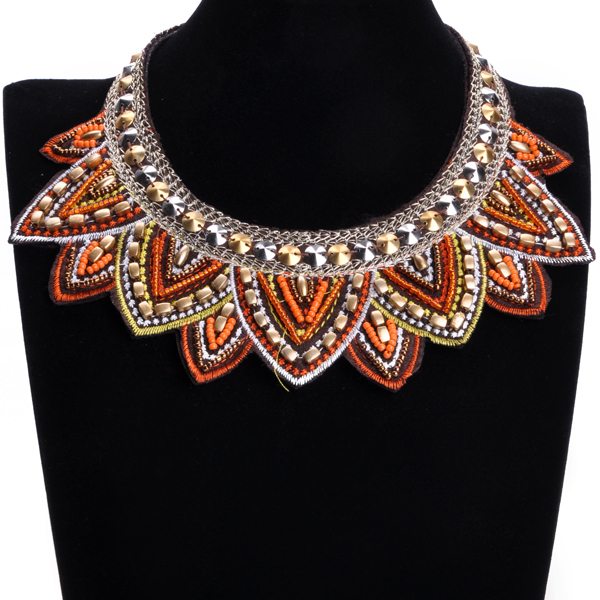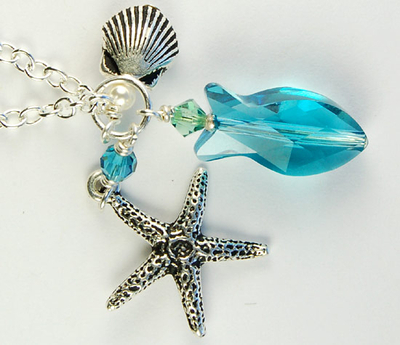Beaded Jewelry Design Ideas Biography
Source (google.com.pk )At the age of 10, Melanie was first introduced to beads in 1969 on the Greek island of Mykonos. An islander showed her how to weave on a loom and from thereon she couldn’t be separated from the beads.
Having a loving and creative Grandmother had fueled Melanie’s love of arts and crafts from an early age and, while her studies led her on the scientific path, she continued to experiment with beading and jewelry making.
However, Melanie’s beading skills really took off in her teens when she taught herself the various beading stitches by following thread paths and mending damaged antique beaded collars, bags, and jewelry she bought at antique fairs and flea markets.
Studies and babies put beading on a back burner, but when Melanie took up a post teaching Secondary Science her beading resurfaced as a relaxing medium to wind down at night time – always one to burn the midnight oil!
In 1999, Melanie attended the first Great British Bead Show and joined The Beadworkers Guild which opened up a world of like-minded people. As a qualified Science teacher and a bead artist with her own designs and ideas, Melanie was encouraged by the Guild to begin teaching. Immediately she began holding private workshops at home, teaching for the Guild, and helped found a local beading group. She soon realized how much she loved to teach beadwork and see that ‘Eureka moment’ when a student gets it and sees the potential to do their own thing!
Melanie’s work has been featured in a number of beading books and she was one of the artists chosen to design a project commemorating the 10th anniversary of The Beadworkers Guild, resulting in her beaded fish Gorgeous Giorgio. Since she began teaching, her work has morphed through a number of styles, most notably influenced by her scientific background in her approach to three-dimensional molecular structures and organic life forms; but she is currently driven by influences from mediaeval times, Byzantium, and the Renaissance, designing exciting crystal jewelry that could have been worn by powerful women.
The use of semiprecious beads are one of the popular beaded jewelry ideas which generally highlight polished stones like the amethyst, fluorite, and rose quartz. These are usually complemented with gemstone chips as well as faceted crystal beads to create striking jewelry like necklaces and bracelets. Other beaded jewelry ideas further include the use of pearl beads which commonly make use of glass pearls that come in three varied colors and sizes. This is to create a necklace strand that is stylishly opera length. The chandelier earrings in crystal beads, on the other hand, use a five prong chandelier design earring items to attach in a loop made atop the headpin.
Bead Necklace Patterns - Easy Guidelines
In customizing beaded patterns at home, gather first the materials for the project like the beading tray, measuring tape, elastic cord, and the beads itself. First thing to do in crafting bead necklace patterns is to place a number of types of beads in the necklace groove of the beading tray. Decide on which bead type you wish to use for the design and then remove the rest out of the tray. Next, line the chosen beads up in the groove. If you are only to use two kinds of beads, set them alternately, while three or more bead types have to be serially placed. This time, arrange the beads according to the order of the bead necklace patterns you have chosen. Wrap the tape measure around your neck and find out the length of necklace you need to work on. Put enough beads in the said pattern that fits the measurement. And then cut a certain length in the elastic cord with an inch allowance left. Finally, nudge the cord through the bead holes in similar order as to the beads as lined up in the tray, then with the use of a simple knot, tie both the cord ends together.
Bead Necklace Designs - Many Varieties
The symmetrical pattern is one of the bead necklace designs that you may consider in choosing the beaded jewelry you wish to obtain. This design generally executes the same string pattern all throughout the piece. Most of the time, the symmetrical design highlights a bead or pendant at the center part of the necklace. Asymmetrical designs, on the other hand, have a much looser pattern since no part of the string is of the same bead order in terms of size or color. Finally, both the multi-strand and woven designs take a little more time in planning the opted necklace style to beautifully maintain the string lengths, how the drapes are elegant enough, and how the circle around the neck is perfectly complements the rest of your outfit.
Katie Hacker is an artist and writer who started designing her own jewelry as a teenager when she couldn't find fashionable clip earrings for her un-pierced ears. She turned her pastime into a business and now makes a living doing what she loves best -- making jewelry and sharing her ideas.
A prolific author, whose books have sold more than half a million copies, Katie provides beading advice as the presenter of Beading Lessons on the PBS series Beads, Baubles & Jewels. She freelances beading projects to a variety of national publications and is the editor of Creativity, one of the world's largest, free crafting e-mail newsletters. She has been commissioned to create original designs for Beadalon, Pure Allure, and other companies.
Katie is passionate about demystifying jewelry making, and she specializes in projects that are fashionable and fun. Her approachable style helps new beaders feel less intimidated and more empowered. "I love helping people find their source of creativity through beads," she says. Her workshops at national venues like the Bead&Button Show feature easy-to-learn techniques for creating boutique-style jewelry.
Beaded Jewelry Design Ideas Jewelry Desgin Sketches Ideas 2014 Neclkace Ring Earringes Gallery Bangles Software Drawing Images Photos Wallpapers

Beaded Jewelry Design Ideas Jewelry Desgin Sketches Ideas 2014 Neclkace Ring Earringes Gallery Bangles Software Drawing Images Photos Wallpapers

Beaded Jewelry Design Ideas Jewelry Desgin Sketches Ideas 2014 Neclkace Ring Earringes Gallery Bangles Software Drawing Images Photos Wallpapers

Beaded Jewelry Design Ideas Jewelry Desgin Sketches Ideas 2014 Neclkace Ring Earringes Gallery Bangles Software Drawing Images Photos Wallpapers

Beaded Jewelry Design Ideas Jewelry Desgin Sketches Ideas 2014 Neclkace Ring Earringes Gallery Bangles Software Drawing Images Photos Wallpapers

Beaded Jewelry Design Ideas Jewelry Desgin Sketches Ideas 2014 Neclkace Ring Earringes Gallery Bangles Software Drawing Images Photos Wallpapers

Beaded Jewelry Design Ideas Jewelry Desgin Sketches Ideas 2014 Neclkace Ring Earringes Gallery Bangles Software Drawing Images Photos Wallpapers

Beaded Jewelry Design Ideas Jewelry Desgin Sketches Ideas 2014 Neclkace Ring Earringes Gallery Bangles Software Drawing Images Photos Wallpapers

Beaded Jewelry Design Ideas Jewelry Desgin Sketches Ideas 2014 Neclkace Ring Earringes Gallery Bangles Software Drawing Images Photos Wallpapers

Beaded Jewelry Design Ideas Jewelry Desgin Sketches Ideas 2014 Neclkace Ring Earringes Gallery Bangles Software Drawing Images Photos Wallpapers

No comments:
Post a Comment